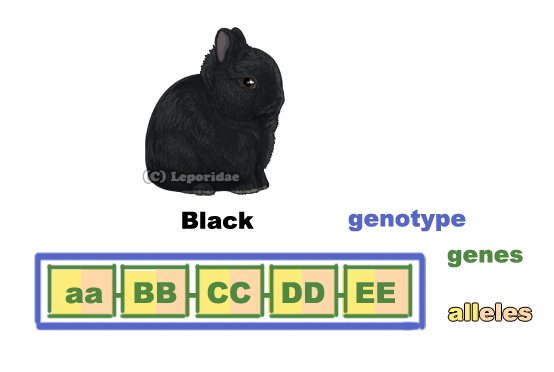Genetics GuideWelcome to Leporidae's official genetics guide for real life rabbit genetics! We understand this is a tricky subject and try to provide
an easy learning resource with plenty of pictures and alternative explanations. |
|
Learning Genetics—Visual & Interactive
Have you ever wanted to learn (or learn more about) rabbit color genetics with some more visual aids?
Leporidae uses a layering system to handle the genetics and images in our game, so we decided to put together a guide (using some of those images) to help
hopefully broaden everyone's understanding of genetics in real life. |
|
 Broken chestnut agouti colored rabbit separated into four layers. |
|
SECTION #1: STRUCTURE OF THE GENOTYPE
Genotype, Genes & AllelesYou've probably heard these words before, but what do they mean? Anyone who wishes to learn genetics should make sure they first understand the basic difference between a genotype, a gene, and an allele. 1) This black Netherland Dwarf has a genotype. A genotype is the whole thing, the big series of letters that genetically describe the color of this rabbit. The genotype of the black rabbit above is aa BB CC DD EE. At first, it may appear to be a string of nonsensical letters, but this 'alphebet soup' is nothing more than a list of genes where each gene is separated by a space. You can include or exclude as many genes as you'd like, but generally speaking, a genotype usually contains five or more genes. 2) There are five genes displayed in this rabbit's genotype. aa is a gene, BB is another gene, and so on. A gene is basically a pair of alleles. There are always two alleles within a gene. You may see more than two letters, but those are still just two alleles making up one gene. There are of course many more genes that affect color (vienna, English spotting, etc.), but we'll go into more detail later. We usually name genes something like the "A series" gene or the "C Locus" or just "D gene." For example, the rabbit above is 'aa' in the A series gene. 3) Alleles are actually the parts that represent color properties in a rabbit. There are different kinds of alleles like agouti and dark chinchilla, which is what we're representing with all those letters. Within each gene, there are always two alleles: one allele is inherited from the mother rabbit, and the other allele is inherited from the father. Which one of those two alleles will be passed down is a 50-50 chance, and that's why we have punnet squares (which we'll talk about later). Keep in mind that alleles might have more than one letter to represent them (like the Cchd allele which has 4 letters as opposed to the A allele which only has one letter). The amount of letters doesn't mean anything, It's just an abbreviation. Once you learn all of the different alleles, you won't have as much trouble making out these big blocks of letters. The Difference Between Genes & AllelesWe'd like to point out a clear distinction between genes and alleles. Alleles are sometimes mistakenly referred to as genes, and we want to make sure you know so you don't get confused when reading other materials or discussing genetics. Sometimes, you may see things like "you need two copies of the [fill in blank] gene," but there cannot be two copies of a gene, They mean alleles. Another one is 'she carries the [fill in blank] gene.' Genes cannot be carried, again they are referring to alleles. You may also see things like "she has the chinchilla gene," which is wording that we will avoid due to it being a little misleading. It seems to suggest that there is a specific gene responsible for chinchilla, which is the case for alleles, but not genes. Yes, chinchilla can be expressed in a gene, but only in an individual rabbit when the chinchilla allele is combined with another allele that allows chinchilla to be expressed. A better way to say this would be "she expresses chinchilla" or "she carries chinchilla." Even "she has chinchilla" is a little more accurate. SECTION #2: FUNCTIONALITY OF DOMINANCE
All Alleles & Ladder of DominanceNow that we have a good understanding of genotypes, genes, and alleles, let's talk about ladder of dominance. Not all alleles are created equal, some are more dominant than others. These rules of dominance are like a natural order of importance for alleles. Think of each gene as a separate ladder, and each allele as a spot on the ladder. The one at the top is the most dominant—the most important. 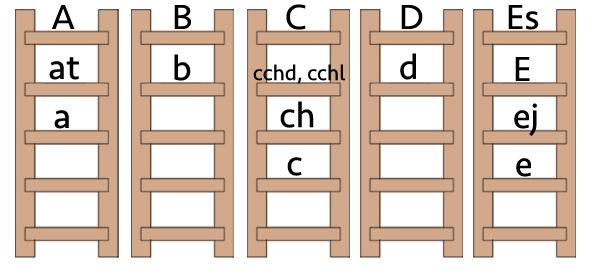 First let's talk about the first ladder. It represents the A series gene. There are three possible alleles for this gene: 1) A, which is the agouti allele. 2) at, which is the tan pattern allele. 3) And a, which is the self allele. In the case of this ladder/gene, A (agouti) is the most dominant and a (self) is the most recessive. The same rules are applied to all other genes, with each have their own unique set of naturally ordered alleles. Dominance & ExpressionSo dominance is just a way of ordering alleles, but what exactly does being 'important' do? Imagine that you're looking directly down at the ladder. The allele at the top is the only one you will see. Similarly, the most dominant allele is what you see on a rabbit. This is called 'expression.' The most dominant alleles are the ones that get expressed in a rabbit's color. The ones that are not expressed are 'carried' and are not visible to someone looking at the rabbit. Any given rabbit can only have two alleles per gene. It cannot have A, at, and a all together. The only possibilities are: have AA, Aa, aa, Aat, atat, ata, or aa. Whatever alleles the rabbit has, it is always the one at the top of the ladder that gets expressed. Agouti is expressed when a rabbit has AA, Aat, or Aa. It can carry tan pattern or self. Agouti cannot be carried. Tan pattern is expressed when a rabbit has atat or ata. It can carry self. Tan pattern can only be carried by agouti. And self is expressed only if the rabbit has aa. Self cannot carry anything, but it can be carried by either agouti or tan pattern. Co-dominance ExplainedYou may notice that cchd and cchl share a spot on the dominance ladder. This is because they are co-dominant. If you imagine yourself looking down at the ladder, you will see both of them at the same time (unless they are covered by C). Similarly, you can see both co-dominant alleles in a rabbit's coat color when they're combined. (Note that ej is also capable of co-dominance with E or Es). SECTION #3: PRACTICAL APPLICATION IN BREEDING
|
|
Breeding & The Punnett SquareThe Punnett Square is a good visual to help detemine possible breeding outcomes based on the alleles of each parent. To the right we have one that shows the possible results of breeding two blacks which both carry chocolate. Because black (B) is the dominant allele, any offspring with at least one copy of B will be black. Chocolate requires two copies of b, so it is only when a rabbit inherots bb that chocolate gets expressed. In other words, these are all possible combinations of the breeding: BB - 25% possibility of black that does not carry anything. Bb - 50% possibility of black that carries chocolate. bb - 25% possibility of chocolate (which cannot carry black). Note: It doesn't matter if you reverse the order of the alleles. bB is the same as Bb, just written incorrectly. |
|
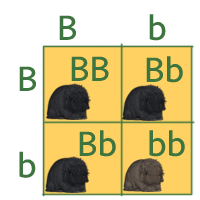 A punnet square showing black's dominance over chocolate. |
|
Gene InteractionsBlack and chocolate in the B gene are basic and easy to understand, but what happens when you add other genes? Every rabbit is either Black or Chocolate depending on the B Series gene, but not all rabbits 'look' Black or Chocolate. For example, a color called Orange (AKA Red, Fawn, or Gold in some breeds) doesn't show much or any Black/Chocolate (besides maybe some discrete signs). Likewise, an Albino rabbit will mask anything. All alleles in other genes mask, hide, and alter each other in different ways, that's the beauty of genetics. One of the easiest to understand interaction is how the D gene affects Black or Chocolate rabbits. That color of a Black or Chocolate can be diluted by the D Series gene, which causes a rabbit to develop less pigment. Black becomes a blue-gray color (Blue) and Chocolate becomes a dove-gray color (Lilac). Dilutetion from the D gene will also cause less pigment in other aspects of the rabbit's color, changing Orange (and the others mentioned above) to a lighter Fawn color if the rabbit happens to be a Orange. If the color is not diluted, we call that "dense." All combinations for the D gene: DD - Dense and does not carry anything. Dd - Also dense, but carries dilute. dd - The only combination that causes dilute. Dense cannot be carried. If there's any uppercase D at all, the rabbit is always dense. |
|

 
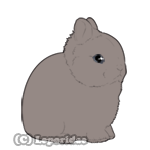 Black, blue, chocolate, and lilac base colors. |
|
SECTION #4: GENES A-W
Moving Right Along!With a lot of the basic functionality of genetics out of the way, the following sections will be about various genes. 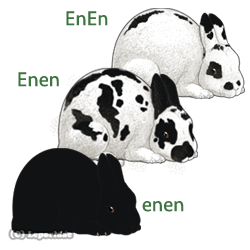 Brokens, Charlies & SolidsBrokens (or English spotted rabbits) are in a gene called the En Series (not the E Series, that's different). Like the B Series and D Series, there are only two possible alleles: En and en. Unlike the B series, all three combinations of alleles in the En gene (EnEn, Enen, enen) cause different patterns. First off, any rabbit with En will be white with spots. You can think of the white parts as a sheet with holes in it, allowing bits and pieces of the rabbit's true color to show through. However, having two copies of EnEn causes extra white, as if you were to lay a second hole-filled sheet over the first one. This of course is called Charlie pattern. 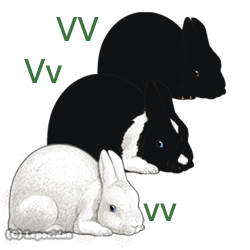 Vienna & Blue Eyed WhiteThe V Series causes blue eyed white and Vienna marked rabbits, which have similar markings to a Dutch rabbit (but are not actually Dutch, the Dutch allele is found in a different gene). Like the En, B, and D genes, the V gene has only two possible alleles (V and v). There are three possibilities when breeding: VV, Vv, and vv. Also like the En gene, there are three different kinds of expression for the two alleles: 1) a rabbit with no vienna at all (VV). 2) Vv, which is called a 'vienna carrier' and can have multiple ways of expressing (or not expressing) vienna. Some vienna carriers do not appear to have any traces of vienna on them, you may never know that the rabbit carries vienna at all. Others might have blue eyes, only one blue eye, or even just specks of blue in one or both eyes. Vienna carriers can also have white markings, which is where the Dutch confusion comes into play the most. The markings on a vienna can look a lot like a Dutch (and since Dutch can also cause blue eyes, you can't always be sure of the difference). Any vienna carrier that has visible signs of vienna is referred to as a 'vienna marked' rabbit. Lastly, if you have a rabbit with vv, it will be completely white with blue eyes. 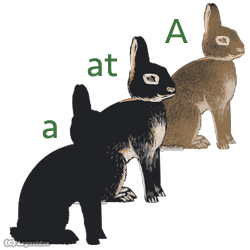 A Series GeneThe A Series gene, unlike all the two allele genes we went over, has three different alleles in it: A (agouti), at (tan pattern), and a (self). 1) Self is the most recessive allele which, when expressed, causes a rabbit to show little to no A series pattern. 2) The most dominant allele, A, causes an agouti pattern, which is responsible for the type of pattern you see in most wild rabbits. The middle allele, at, causes a partial expression of pattern that shows on the underbelly, chest (sometimes all the way up the neck), nape of the neck, inside ears, around jowels and nostrils, around eyes, the underside of the tail, and on the feet. 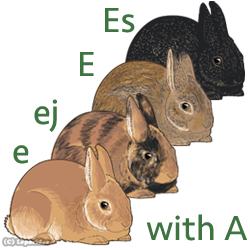 E Series Gene with Agouti (A)In the E Series, we add yet another allele to the mix from our previous look at the A series. The E series changes how much color is on the rabbit verses the base (black, bliue etc.). Like the A Series, it does not determine the actual color, but how much or how little is shown and where. It also controls how far the base color extends through the hair shaft. Shown above is the E series alleles combined with Agouti (A). e - Lowercase e (called non-extension) causes almost full color straight down to the skin like in Oranges, Fawns, and Ermine/Frosted. ej - The Harlequin allele causes color (both top color and hair shaft) to be brken up, exposing the base underneathe. The 'harlequin' pattern (which umbrellas both Japanese and magpie) can either be very clean or appear messy (and everything in between). ej is one of the more complicated alleles because of its ability to be co-dominant. When you have an agouti rabbit with ejej or eje, the rabbit will mimic a non extension look on the colored parts. When you have an agouti with Eej, it is possible to get a full extension look in addition to harlequin markings (both harlequinized chestnut and harlequinized chinchilla are possible). The same can happen with Steel when you have an agouti with Esej. E - The full extension uppercase E is considered the normal amount of color. Full extension agouti rabbits generally have color intersperced with base color and with base undercolor in the hairshaft (along with colored rings). This is the typical pattern of wild rabbits. Es - The Steel allele is interestingly the most dominant and yet not the most frequently seen in the wild. It causes the base color to extend further towards the tip of the hair shaft, lessening the amount of color that shows on the rabbit. A Black Gold-Tipped Steel is basically a Chestnut Agouti with more Black showing (a Black Silver-Tipped Steel is the same thing but with Chinchilla). This is why EsEs (double steel) is usually Black. It causes so much Black that little to none of the Chestnut will show. 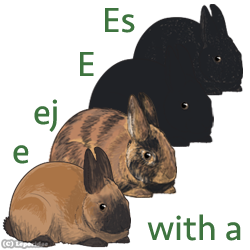 E Series Gene with Self (a)The E Series and A Series work together to determine how much color is shown. When combined with Self, it looks a little different. e - Tortoise and Orange/Fawn are both non-extension colors with the only difference being that Orange/Fawn is Agouti and Tortoise is Self. On a Tortoise, the longer hairs get color, and the shorter ones get the base. So areas on the rabbit where the hair is shortest are darker, such as on the face, ears, feet, tail, and to a lesser extent, the flanks and belly. Don't make the mistake of confusing non extension self (tortoise or sallander, which is the chinchilla version of tort) with shaded. Shaded is an allele in the C gene and is not related. ej - Again, ej gets tricky. When eje is self instead of agouti, you will get a "torted Harlequin." Torted harlequins are exactly as they sound—tortoise rabbits with harlequin markings. However, if you have a self rabbit with ejej, it will not appear to have the same markings as a tortoise. E - Full extention causes normal expression of the base color, so with self, there's no color. If you have a full extension self black, you will have a black rabbit. Es - Steel will be wiped out by self, causing the rabbit to be only its base color with a few colored hairs at most. 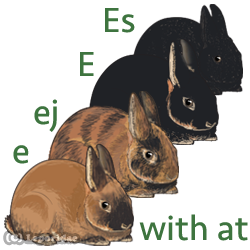 E Series Gene with Tan (at)Again, there are slight difference in the result when the E Series is working with at. e - Remember that Tortoise occurs because only base color shows on self. With tan pattern, the same thing happens. Th only difference is the tan pattern will also be present. You get a torted otter (aka fox). ej - This is a rarer combination, so you may not even find pictures of this. We had trouble finding some to confirm what this should do. It is a combination of tortoise, otter, and harlequin. The otter part turns into base color where the harlequin is broken up and torted. On some rabbits, it may not show up very well. E - Full extension causes normal tan pattern coloring, which is responsible for colors like otter, tan, and silver marten. Es - Like self, tan pattern causes steel to disappear. Because the color on the top side of the rabbit has no color in tan pattern, it dimishes the steel color. 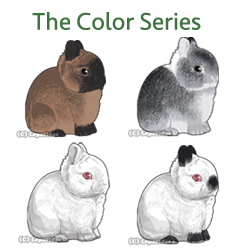 C Series GeneNow we're getting into the C Series, which deals with color pigment. It is responsible for colors like chinchilla, sable, ruby eyed white (albinism), and himalayan/pointed white. C - C means full color and is the most dominant of the C Series. You can think of it as not actually doing anything at all. In all of the other pictures we've shown so far, the colored rabbits were all expressing C. cchd - The Chinchilla allele is second in dominance. It removes color pigment in the colored areas, not affecting base color. Let's look at what happens when it's paired with full extension (E). 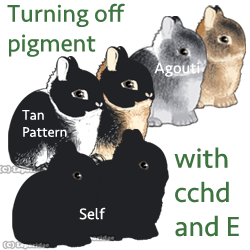 cchd, E, and the A SeriesA - cchd is best known for turning chestnut into chinchilla, opal to squirrel, chocolate agouti into chocolate chinchilla, etc. It takes all the orange pigment and turns it into white, leaving the base color unaltered. at - cchd is also well known for turning otters (and tans too) into silver martens (aka fox in the UK). Again, it takes all the orange pigment, turns it white, and leaves the base unaltered. a - You might hear people talk about "self chinchilla." That's what this is. Because cchd doesn't change the base color, if you have aa BB cchdcchd EE, you will still have a black rabbit. 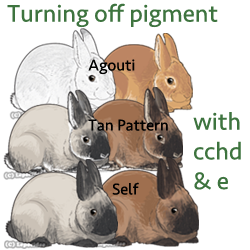 cchd, e, and the A SeriesWhat happens if, instead of full extension, you have non extension? Non extension means that the base color does not extend through the hair shaft, so when color is also turned off by cchd, some of the results are pretty interesting. A - Because of Non Extension, agouti is expressed as orange/fawn. With color turned off, the orange turns white. This is the color known as frosted or ermine. There is usually a little bit a base color peaking through, especially at the tips of the ears and maybe on the tail or other parts of the body. a - Self combined with cchd causes sallander, which is a tortoise that had its color turned off. It looks similar to a sable point, but is genetically different. Sallanders tend to have tortoise-like markings (dark underside and flanks especially) that give their identity away. at - Remember that tan pattern with non extension causes torted otter. Torted marten (with white tan pattern) is not possible. Instead, if cchd removes the color of a torted otter, you're left with a martenized sallander. 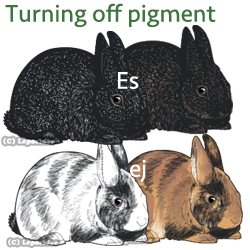 cchd with Steel (Es) and Harlequin (ej)Last but not least is an example of cchd removing color from Japanese harlequin, creating magpie) and gold-tipped steel, creating silver-tipped steel). We're not going into too much depth, there are many more possibilities for cchd, but you have a good idea now of what it does when placed into different situations. 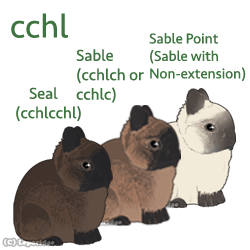 Sable, Seal & Sable Point (cchl)cchl also removes orange pigment, but in a different way, also causing the base to show through at the rabbit's extremities (face, ears, feet, tail). It is responsible for colors like sables, seals, sable points, seal points, sable martens, seal martens, and smoke pearls. cchl is co-dominant with cchd, which is a fancy way of saying that both can be expressed at the same time. This results in colors like shagouti (or sable chinchilla), which have both agouti and shaded markings. With full extension: cchlcchl - When two copies of cchl are combined, you mat get a very dark rabbit known as seal (blue seal, chocolate seal, and lilac seal too). Seals are often mistaken for blacks, blues, chocolates, and lilacs because the darker extrememities might be impossible to distinquish. cchlch or cchlc - Either of these causes sable. Sables cannot have two copies of cchl, they must either carry the ruby eyed white or himalayan/pointed white allele. This lightens the color of considerably as opposed to seals (where there's just another shaded allele). Sable can also be chocolate sable or become smoke pearl or lilac based smoke pearl when diluted. With non extension: cchlcchl - If non extension is expressed, what would normally be a dark seal instead becomes seal point. The colored parts are turned an off-white by non extension. Seal point is very similar to sable point in appearance. Usually, seal points have darker tones and smut compares to sable points. cchlch or cchlc - With non extension being expressed, sable, smoke pearl etc. becomes sable point, chocolate point, blue point, etc. Again, non extension turns the colored parts of the rabbit to an off-white. 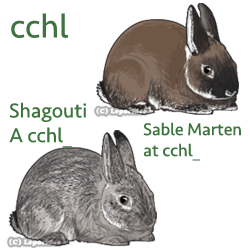 cchl with Agouti (A) and Tan Pattern (at)Sables, seals, and sable/seal points are all self (a). Here's what happens when you have an agouti or tan pattern instead. at & cchlcchl - This creates seal marten, a dark version of sable marten that can also be any base and is easily mistaken for silver marten (silver fox in the UK), blue marten, etc. at & cchlch or cchlc - This creates sable martens, smoke pearl martens, and the other bases of those. Note that because the cchl removes color, otter and tan are not possible. It always turns them into marten. We do have smoke pearl tans on Leporidae, but those are just for fun and not possible in real life. at & cchlcchl with e - If non extension, again, sable point, blue point etc. and the seal points of any bases all get martenized. A & cchlcchl, cchlch, or cchlc - All these combinations will cause a straight up awesome mixture of shaded and agouti chinchilla, so you will have an agouti with dark points. They will always have chinchilla-like color because of how cchl removes orange pigment. This combination is sometimes called shagouti, sable chinchilla, or shaded chinchilla. A & cchlcchl, cchlch, or cchlc with e - This will cause ermine/frosted to have shaded-like markings, often called frosted sable or is named as accurately as possible (it's usually hard to tell what's underneath all the white). A & cchlcchl, cchlch, or cchlc with ej - Yes, shaded can be mixed with harlequin and is very awesome indeed. It may appear somewhat like a sable point due to cchl removing color, and ej mimicking non extension. 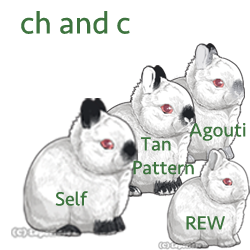 Himalayan/Pointed White & Ruby Eyed White (albino)Finally, we come to an easy finish with the last two and most recessive C Series alleles. Himalayan/pointed white is a temperature sensitive color, causing the base to show where there is less heat on the rabbit (usually at the extremities). The base color is unaffected, but orange pigment is. So if tan pattern is expressed rather than self, it will be martenized by ch (no otter or tan on these guys). If the rabbit expresses agouti, the agouti will show as chinchilla rather than chestnut. It can also be ermine/frosted with the expression of non extension, making an almost all white rabbit with red eyes that might some color on the tips of the ears, tail, or around the nose. Or it could be combined with magpie or silver-tipped steel. Ruby eyed white is the most recessive and a very simple color. It is albino, having no color pigment, and therefore (like blue eyed white), masks whatever is underneathe. The only colors it cannot mask are the ones caused by alleles in the C series gene because it is already the most recessive of the C series. It is incapable of carrying any other alleles. Final notes...There is always something new to learn about rabbit genetics, especially because not everything is known, or information isn't readily available! We've enjoyed writing this guide and hope that you've had a good time reading it too, or at least got something out of it. Visuals always help, and getting to breed and test out your knowledge on Leporidae can help too. |
|

